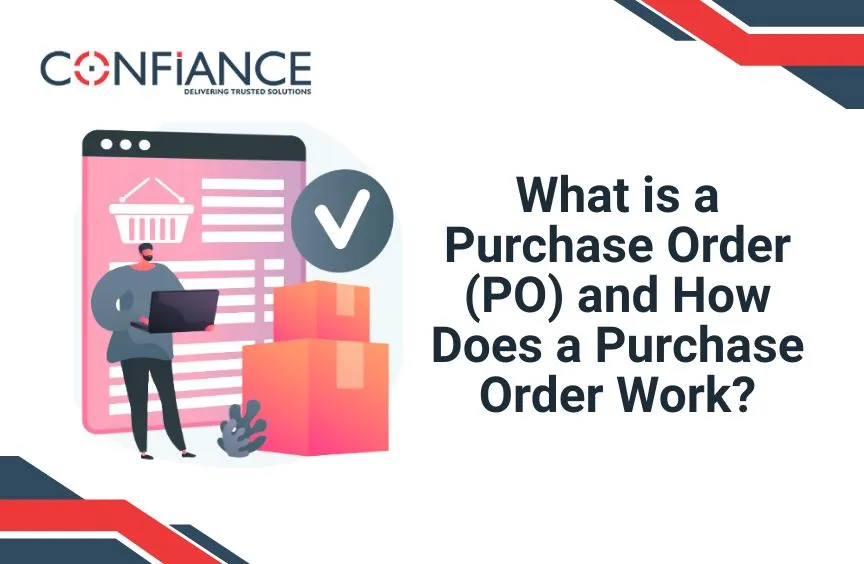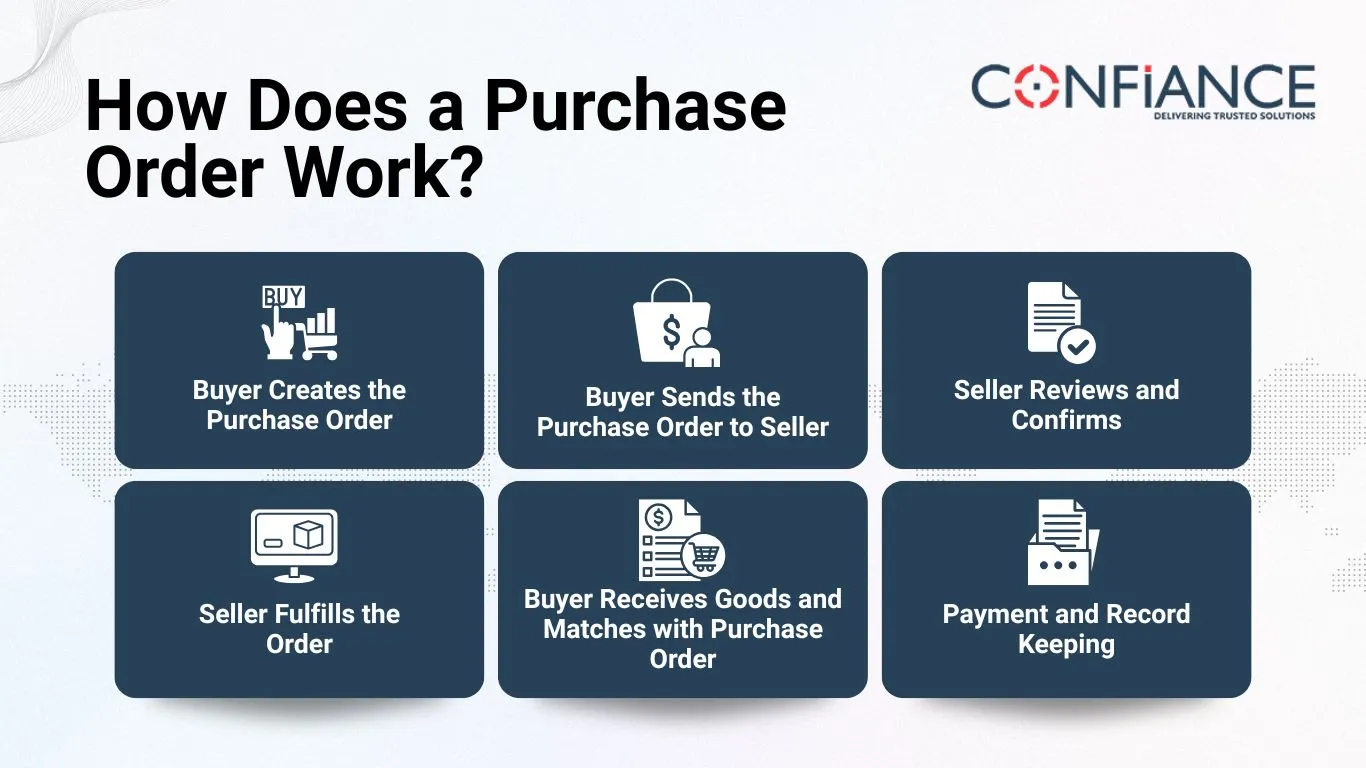
What is a Purchase Order (PO) and How Does a Purchase Order Work?
A Purchase Order is one of the most common tools in business. When a company needs goods or services, it often creates a PO to make the process clear and safe. This document tells the supplier what the buyer wants, how much is needed, and when it should be delivered. By using a PO, both the buyer and the seller stay on the same page, which reduces errors and builds trust.
Understanding the Basics of a Purchase Order
A Purchase Order is a short note from a buyer to a seller. It lists the items, the number of units, the cost, and the delivery day. When the seller agrees, the PO becomes a deal that both sides must follow.
Why Businesses Use PO:
- They give clear rules for both buyer and seller.
- They cut fights about count, price, or arrival.
- They help track spending and plan the budget.
- They give a record for checks or audits.
- They make it easy to compare past orders and see trends.
- They help staff follow the right steps and avoid mistakes.
- They keep proof of what was agreed upon, if any issues come up.
The Main Elements of a Purchase Order
Every Procurement order includes certain details. These elements keep the process smooth and clear.
Buyer and Seller Details
Names, addresses, and contact details are included so both sides know exactly who they are dealing with.
Product or Service Description
This part lists what is being ordered. It includes item names, models, or service details.
Quantity and Price
A PO always includes the exact number of units and the agreed cost per unit.
Delivery Date and Location
The PO tells the seller when and where the goods or services should be delivered.
Payment Terms
This section sets out how and when the seller will receive payment, such as 30 days after delivery.
How Does a Purchase Order Work?
The flow of a Purchase Order is clear and simple. It guides both buyer and seller step by step, so orders run smoothly, costs stay tracked, and records stay safe.
Step 1: Buyer Creates the Purchase Order
The buyer makes a PO with key facts like item name, count, price, and when it should arrive. This makes sure needs are clear before any deal starts.
Step 2: Buyer Sends the Purchase Order to Seller
The buyer sends the PO to the seller. This step shows the seller what is needed, how much, and when. It avoids guesswork and sets clear ground.
Step 3: Seller Reviews and Confirms
The seller reads the PO and checks the facts. If all looks right, they say yes. This turns the PO into a deal both sides must follow.

Step 4: Seller Fulfills the Order
The seller then ships the goods or gives the service as per the PO. This step makes sure the buyer gets what was asked for in the first place.
Step 5: Buyer Receives Goods and Matches with Purchase Order
The buyer takes the order and checks it with the PO. They make sure the right items come in the right count, at the right time, with no gaps.
Step 6: Payment and Record Keeping
When all matches, the buyer pays as per the PO terms. Both buyer and seller then keep the PO as proof for spending checks, taxes, or audits.
The Benefits of Using a Purchase Order
Clear Communication
A Procurement Order avoids confusion by showing exact needs.
Budget Control
Since POs include cost, they help businesses manage and plan budgets.
Legal Protection
If disputes arise, a signed PO can act as proof of the agreed deal.
Audit Trail
POs serve as a financial record, which helps in audits and compliance checks.
Common Types of Purchase Orders
Not all Purchase Orders are the same. Businesses may use different types based on their needs.
Standard Purchase Order
This is the most common type. It includes all details like item, price, and date.
Blanket Purchase Order
Used when a buyer agrees to buy goods over time, often with set prices but flexible delivery dates.
Contract Purchase Order
This PO is tied to a long-term contract between buyer and seller.
Planned PO
It includes item and pricing details, but not the exact delivery schedule.
Difference Between a Purchase Order and an Invoice
| Point | Purchase Order | Invoice |
| Who Creates It | Buyer creates and sends to seller | The seller creates and sends to the buyer |
| When Issued | Sent before goods or services are delivered | Sent after goods or services are delivered |
| Main Purpose | To request and confirm goods or services | To ask for payment from the buyer |
| Key Details | Item type, price, quantity, and delivery terms | Price, payment terms, and total due |
| Legal Role | Acts as a contract once accepted by the seller | Acts as a bill that the buyer must pay |
| Record Keeping | Helps track orders and control spend | Helps track payments and cash flow |
How Purchase Orders Help Businesses Grow
A well-structured PO system is more than just paperwork. It adds real value to business growth.
Better Vendor Relationships
Suppliers appreciate clear POs, which improve trust and reduce back-and-forth discussions.
Reduced Errors
Since everything is in writing, mistakes with orders or payments are less likely.
Efficient Operations
POs streamline the buying process, saving time and effort for staff.
Purchase Order in Small vs. Large Businesses
Small Businesses
Small companies may not always use an Order form for every purchase, but using one helps as they grow. It builds good habits and clear records.
Large Businesses
Larger firms almost always rely on an order form. With high spending and many vendors, a PO system ensures smooth management.
Paperless orders and Automation
With digital tools, many companies now use software to create and track Procurement Orders.
Benefits of Digital POs
- Faster approval and tracking.
- Less paperwork and errors.
- Easy integration with accounting software.
- Real-time updates on order status.
Best Practices for Managing Purchase Orders
Managing POs well saves time and money. Clear steps help teams avoid mistakes and work fast.
Keep Details Right
Mistakes in codes or prices can slow orders. Always check twice before sending. Check items and costs every time.
Use a Simple Format
A standard layout helps both buyer and seller read and process POs fast. Use the same style each time.
Track and Save Records
Keep all POs for audits, budgets, and future use. Store them in a file or online system.
Train Your Staff
Teams should know how to make and handle POs to avoid errors. Teach new staff the steps well.
Set Approval Steps
Have a manager approve bigger orders to prevent mistakes. This keeps spending in check.
Check POs Often
Look at past orders to find errors and save money. Spot trends that can cut costs.
Use PO Numbers
Give each PO a unique number to track and report easily. It makes search and audit fast.
Real-Life Example of a Procurement Order Process
Imagine a retail store needs 500 units of bottled water for an event.
- The store manager creates a PO for 500 units with delivery details.
- The PO is sent to the supplier.
- The supplier checks and confirms the PO.
- The supplier delivers the bottled water on the set date.
- The store checks the delivery against the PO.
- The supplier sends an invoice, and the store pays the amount agreed in the PO.
This simple example shows how effective and clear a purchase order system can be.
A Purchase Order is more than a form; it is the base of clear deals with vendors, and at Confiance, we make this task simple for our clients. We give full support in purchase order creation, review, and tracking, so each step is fast and free of error. Our team links the purchase order process with your accounts and reports, which means you can plan costs, check spend, and keep records with ease. With us, you gain smooth vendor ties, fewer delays, and full control of each order. Our goal is to help you save time, cut stress, and grow while we handle the details of your purchase orders.
FAQs
1. What is the main purpose of a Purchase Order?
It shows clear terms between the buyer and the seller. It lists what is ordered, the cost, and when it should be sent.
2. Is a PO legally binding?
Yes. When a seller agrees to a PO, it becomes a legal deal that protects both the buyer and the seller.
3. How is a PO different from an invoice?
A PO is made by the buyer before items are sent. An invoice is made by the seller after delivery to ask for payment.
4. Do small businesses need to use a PO?
Small firms do not need a PO for every purchase. Still, it helps them keep clear records, avoid mistakes, and plan growth well.
5. Can a Procurement Order be canceled?
Yes, but only if both the buyer and the seller agree. After a PO is accepted, canceling may follow the terms listed in it.
6. Are Procurement Orders important for audits?
Yes, it serves as proof of spending and helps show that rules and policies were followed during audits.
